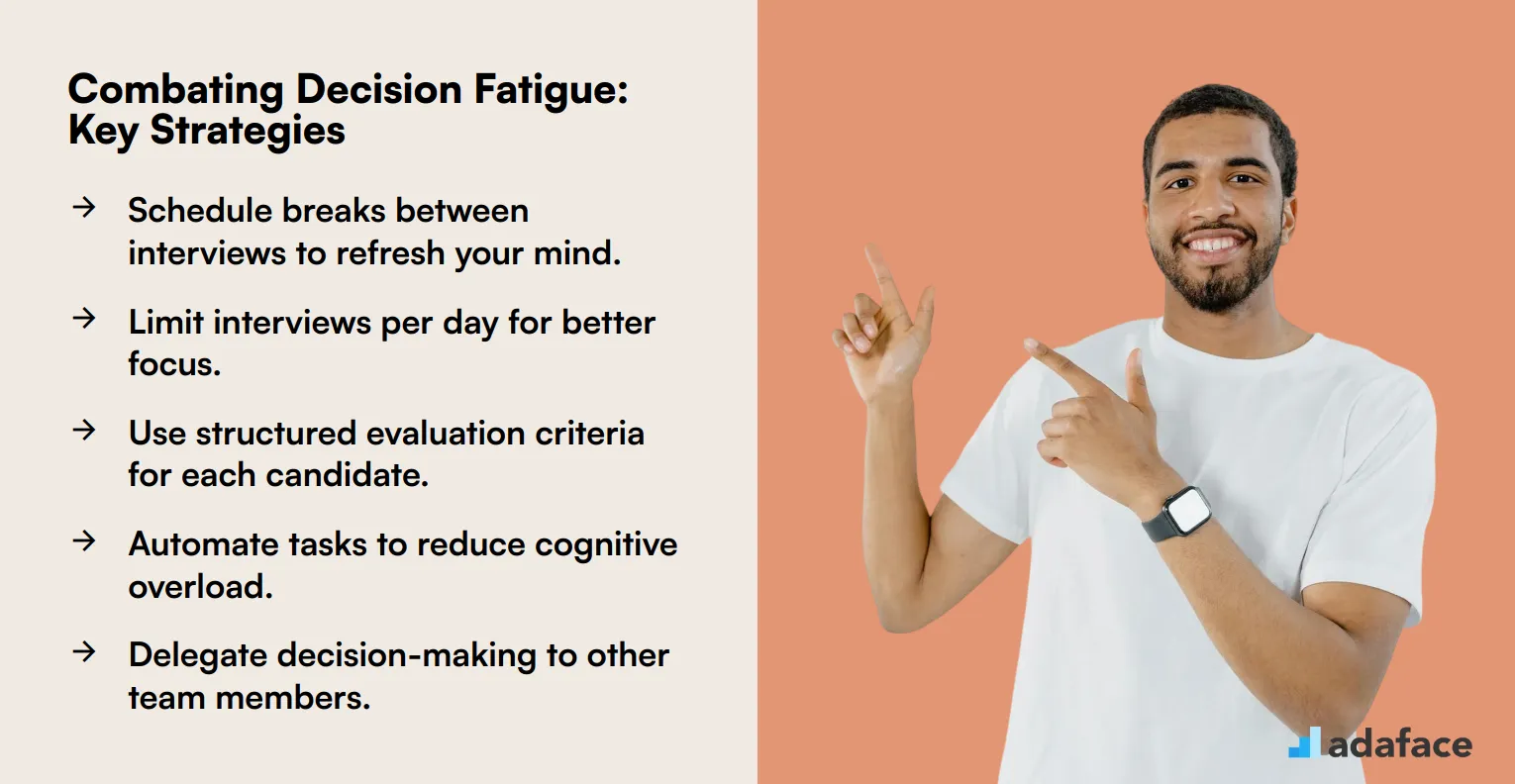Recruiters face countless decisions daily, leading to decision fatigue. This mental exhaustion can impact the quality of hiring decisions, affecting team dynamics and company growth.
Understanding decision fatigue is crucial for recruiters aiming to reduce hiring errors. By recognizing its signs and implementing strategies to combat it, recruiters can maintain sharp decision-making skills.
Table of contents
What is decision fatigue?
Decision fatigue refers to the mental exhaustion that occurs after making numerous decisions. It's a psychological phenomenon where the quality of decisions deteriorates as a person becomes mentally drained from decision-making tasks.
In the context of recruitment, decision fatigue can significantly impact the hiring process. Interviewers and hiring managers may find their judgment clouded after conducting multiple interviews or reviewing numerous applications in a short period.
The effects of decision fatigue can manifest in various ways during recruitment. These may include rushing through candidate evaluations, relying too heavily on first impressions, or defaulting to the easiest option rather than the best one.
Understanding decision fatigue is crucial for maintaining fairness and effectiveness in the recruitment process. By recognizing its signs, HR professionals can implement strategies to mitigate its impact and ensure consistent, high-quality hiring decisions.
To combat decision fatigue, it's important to structure the recruitment process efficiently. This might involve scheduling breaks between interviews, limiting the number of interviews per day, or using standardized evaluation criteria to reduce the cognitive load on interviewers.

Signs of decision fatigue in recruitment
Decision fatigue can creep into the recruitment process without recruiters even realizing it. One of the most common signs is when hiring managers start feeling overwhelmed by the number of choices they need to make, leading to slower decision-making. This can result in a tendency to rely on shortcuts, such as defaulting to familiar candidates or sticking rigidly to past criteria, which can potentially overlook diverse talent.
Another sign of decision fatigue is a noticeable decline in the quality of decisions made. Recruiters might find themselves second-guessing their choices or feeling less confident about hiring decisions, which can impact the overall recruitment process negatively. This can also manifest as a reluctance to engage with new or innovative recruitment strategies, sticking instead to the status quo.
Additionally, decision fatigue can lead to increased stress and burnout among recruitment teams. The constant pressure to make the right choice can become overwhelming, leading to decreased motivation and productivity. This stress can trickle down to candidates, affecting their experience and potentially harming the employer brand.
Lastly, decision fatigue can result in a higher rate of errors or oversight during the recruitment process. Important details might be missed, or follow-ups with promising candidates might be delayed, affecting the quality of hires. Recognizing these signs early can help recruiters take steps to mitigate decision fatigue and maintain an effective hiring process.
How decision fatigue affects hiring choices
Decision fatigue can significantly impact the quality of hiring choices made by recruiters and hiring managers. As the day progresses and more decisions are made, the mental energy available for thoughtful decision-making diminishes, potentially leading to suboptimal candidate selections.
One common effect is the tendency to default to safer, more conventional choices rather than thoroughly evaluating unique or innovative candidates. This can result in missed opportunities to bring fresh perspectives and diverse talents into the organization.
Another consequence is an increased likelihood of making biased decisions based on superficial factors or first impressions. Tired minds may rely more heavily on stereotypes or gut feelings rather than objectively assessing a candidate's qualifications and potential fit.
Decision fatigue can also lead to rushed judgments and shortened interview processes. Recruiters may be tempted to cut corners or skip important steps in the evaluation process, potentially overlooking red flags or failing to gather crucial information.
To combat these effects, it's advisable to schedule important hiring decisions earlier in the day when mental resources are at their peak. Additionally, implementing structured interview processes and using objective assessment tools can help maintain consistency and reduce the impact of decision fatigue on hiring outcomes.
Strategies to combat decision fatigue
Decision fatigue can significantly impact the recruitment process, leading to suboptimal hiring decisions. To combat this, it's important to implement strategies that help alleviate the mental load of decision-making.
One effective approach is to streamline the interview process by using structured interviews. This ensures that every candidate is assessed using the same criteria, reducing the cognitive load on interviewers and minimizing bias.
Another strategy is to incorporate recruitment automation tools that handle repetitive tasks. By automating tasks such as resume screening and scheduling interviews, recruiters can focus their energy on more critical decision-making aspects.
Taking regular breaks during long hiring sessions can also help reset mental energy. Short breaks can improve focus and reduce the likelihood of making errors due to fatigue.
Finally, fostering a collaborative hiring environment can distribute the decision-making burden. Engaging multiple team members in the hiring process allows for diverse perspectives and shared responsibility, enhancing the overall quality of hiring decisions.
Tools to streamline decision-making
Recruitment and HR professionals often face decision fatigue due to the numerous choices they must make daily. Implementing tools to streamline decision-making can significantly reduce this burden and enhance productivity.
An applicant tracking system (ATS) can help manage and organize candidate information efficiently. It allows recruiters to track applications, schedule interviews, and communicate with candidates seamlessly.
Incorporating AI-driven recruitment chatbots can automate initial candidate interactions. These chatbots can answer frequently asked questions and pre-screen candidates, saving valuable time for recruiters.
Utilizing data analytics tools can provide insights into recruitment metrics, helping to identify bottlenecks in the hiring process. By analyzing data, HR teams can make informed decisions and improve their recruitment strategies.
Finally, adopting collaborative platforms can foster better communication among team members. These platforms enable sharing of candidate evaluations and feedback, ensuring a more unified decision-making process.
Building a decision-friendly interview process
Creating a decision-friendly interview process is key to reducing decision fatigue for recruiters and hiring managers. By structuring interviews effectively, you can ensure a smoother and more efficient hiring experience.
Start by implementing structured interviews, where each candidate is asked the same set of questions. This reduces bias and helps in comparing candidates fairly. Additionally, using a candidate rubric can standardize evaluations, making it easier to identify top talent.
Incorporate breaks between interviews to allow interviewers to recharge and maintain focus. Avoid scheduling too many interviews in a single day, as this can lead to exhaustion and poor decision-making.
Utilize technology, such as applicant tracking systems, to streamline the scheduling and feedback process. These tools can help in managing candidate information and ensure that nothing falls through the cracks.
Lastly, involve multiple team members in the interview process to gather diverse perspectives. This collaborative approach not only reduces the burden on individual interviewers but also enhances the overall quality of hiring decisions.
Conclusion
Decision fatigue is a real challenge in recruitment, but it's not insurmountable. By recognizing the signs and implementing strategies to combat it, recruiters and hiring managers can make better decisions and improve their hiring outcomes.
Tools and streamlined processes play a key role in reducing decision fatigue. By leveraging these resources and building a decision-friendly interview process, recruitment teams can maintain their energy and focus throughout the hiring journey.
Remember, the goal is to make informed decisions, not quick ones. Take breaks, prioritize tasks, and use the strategies outlined in this post to keep decision fatigue at bay and hire the best candidates for your organization.
Decision Fatigue FAQs
Employers can prevent employee ghosting by maintaining open communication, setting clear expectations, and ensuring a positive candidate experience throughout the hiring process.
Ghosting is on the rise due to increased job opportunities, poor candidate experience, and lack of communication from employers during the recruitment process.
Signs include procrastination, feeling overwhelmed, making impulsive decisions, and experiencing stress or anxiety when faced with choices.
Decision fatigue can lead to rushed or poor hiring decisions, negatively impacting team performance and increasing turnover rates.
Strategies include prioritizing tasks, taking regular breaks, using decision-making tools, and delegating responsibilities to reduce mental load.
Tools such as applicant tracking systems, AI-driven recruitment platforms, and structured interview processes can help streamline decision-making.

40 min skill tests.
No trick questions.
Accurate shortlisting.
We make it easy for you to find the best candidates in your pipeline with a 40 min skills test.
Try for freeRelated terms



